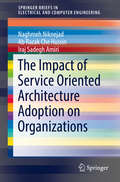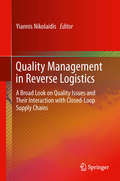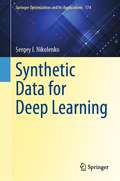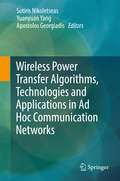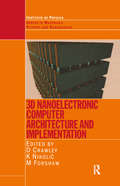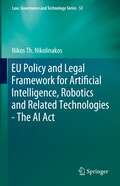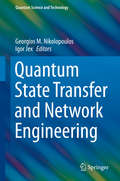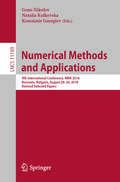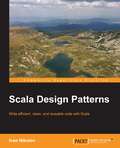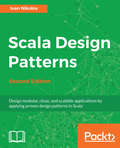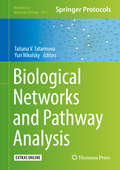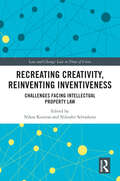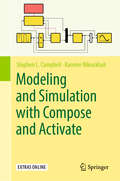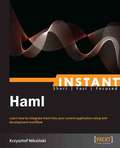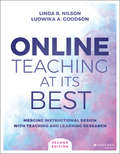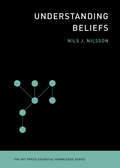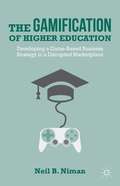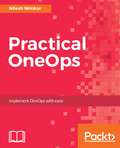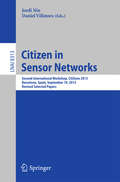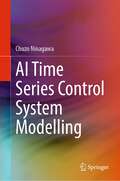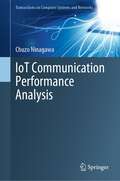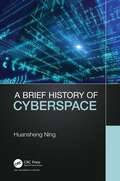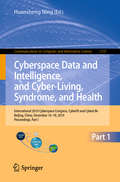- Table View
- List View
The Impact of Service Oriented Architecture Adoption on Organizations (SpringerBriefs in Electrical and Computer Engineering)
by Naghmeh Niknejad Ab Razak Hussin Iraj Sadegh AmiriThis book describes Service-Oriented Architecture (SOA) and the significant factors which affect its adoption, such as governance, strategy, complexity, Return on Investment (ROI), business and IT alignment, culture and communication, costs, and security. The study on which this book is based, involved a quantitative analysis to investigate the influential factors for adopting SOA, paving the way to further research in the field.
Quality Management in Reverse Logistics
by Yiannis NikolaidisQuality Management in Reverse Logistics intends to develop, collect, examine and evaluate a number of quality management (QM) tools and techniques, which can be applied in practice in order to understand, review and improve any closed-loop supply chain process. In other words, the book aims to examine the existing relationship between various well-developed and thoroughly studied quality issues, such as QM, quality assurance, standardization of processes and statistical quality control and the emerging research area of reverse logistics. Quality Management in Reverse Logistics contains modeling and quantitative methods that could be used by practitioners and academics in the reverse logistics industry, as well as a thorough description of QM tools and techniques. The book leads the potential reader to broaden their scope of thinking and acting in the new, promising area of reverse logistics, where QM can be applied.
Synthetic Data for Deep Learning (Springer Optimization and Its Applications #174)
by Sergey I. NikolenkoThis is the first book on synthetic data for deep learning, and its breadth of coverage may render this book as the default reference on synthetic data for years to come. The book can also serve as an introduction to several other important subfields of machine learning that are seldom touched upon in other books. Machine learning as a discipline would not be possible without the inner workings of optimization at hand. The book includes the necessary sinews of optimization though the crux of the discussion centers on the increasingly popular tool for training deep learning models, namely synthetic data. It is expected that the field of synthetic data will undergo exponential growth in the near future. This book serves as a comprehensive survey of the field. In the simplest case, synthetic data refers to computer-generated graphics used to train computer vision models. There are many more facets of synthetic data to consider. In the section on basic computer vision, the book discusses fundamental computer vision problems, both low-level (e.g., optical flow estimation) and high-level (e.g., object detection and semantic segmentation), synthetic environments and datasets for outdoor and urban scenes (autonomous driving), indoor scenes (indoor navigation), aerial navigation, and simulation environments for robotics. Additionally, it touches upon applications of synthetic data outside computer vision (in neural programming, bioinformatics, NLP, and more). It also surveys the work on improving synthetic data development and alternative ways to produce it such as GANs. The book introduces and reviews several different approaches to synthetic data in various domains of machine learning, most notably the following fields: domain adaptation for making synthetic data more realistic and/or adapting the models to be trained on synthetic data and differential privacy for generating synthetic data with privacy guarantees. This discussion is accompanied by an introduction into generative adversarial networks (GAN) and an introduction to differential privacy.
Wireless Power Transfer Algorithms, Technologies and Applications in Ad Hoc Communication Networks
by Sotiris Nikoletseas Yuanyuan Yang Apostolos GeorgiadisThis book is the first systematic exposition on the emerging domain of wireless power transfer in ad hoc communication networks. It selectively spans a coherent, large spectrum of fundamental aspects of wireless power transfer, such as mobility management in the network, combined wireless power and information transfer, energy flow among network devices, joint activities with wireless power transfer (routing, data gathering and solar energy harvesting), and safety provisioning through electromagnetic radiation control, as well as fundamental and novel circuits and technologies enabling the wide application of wireless powering. Comprising a total of 27 chapters, contributed by leading experts, the content is organized into six thematic sections: technologies, communication, mobility, energy flow, joint operations, and electromagnetic radiation awareness. It will be valuable for researchers, engineers, educators, and students, and it may also be used as a supplement to academic courses on algorithmic applications, wireless protocols, distributed computing, and networking.
3D Nanoelectronic Computer Architecture and Implementation (Series in Material Science and Engineering)
by K. Nikolic M. Forshaw David CrawleyIt is becoming increasingly clear that the two-dimensional layout of devices on computer chips hinders the development of high-performance computer systems. Three-dimensional structures will be needed to provide the performance required to implement computationally intensive tasks. 3-D Nanoelectronic Computer Architecture and Implementation reviews the state of the art in nanoelectronic device design and fabrication and discusses the architectural aspects of 3-D designs, including the possible use of molecular wiring and carbon nanotube interconnections. This is a valuable reference for those involved in the design and development of nanoelectronic devices and technology.
EU Policy and Legal Framework for Artificial Intelligence, Robotics and Related Technologies - The AI Act (Law, Governance and Technology Series #53)
by Nikos Th. NikolinakosArtificial Intelligence (AI) can benefit our society and economy, but also brings with it new challenges and raises legal and ethical questions. According to the author of this comprehensive analysis, it is imperative to ensure that AI is developed and applied in an appropriate legal and regulatory framework that promotes innovation and investment and, at the same time, addresses the risks associated with certain uses of AI-related technologies.Essential to understanding the relationship between policy and law, this book traces the evolution of EU policy on artificial intelligence and robotics, focusing in particular on the EU’s ethical framework for AI, which defines trust as a prerequisite for ensuring a human-centric approach.The main part of the book provides a thorough and systematic analysis of the Commission’s 2021 proposed AI Act, which establishes harmonised rules for the development, placement on the market and use of AI systems in the EU. The author painstakingly compares the Commission’s proposed AI Act with the numerous “compromise” proposals of the Council of the European Union, leading to the final version of the Council’s AI Act (general approach) and its formal adoption on 6 December 2022. The author also examines with extraordinary detail the amendments proposed by the relevant committees and political groups of the European Parliament, revealing the position the Parliament is likely to adopt in the forthcoming negotiations with the Commission and the Council on the text of the AI Act.Numerous legislative and policy documents are presented in detail, while the analysis also considers the comments made by all interested parties (e.g. the European Commission, Council of the European Union, European Parliament, governmental organisations, national competent authorities, and stakeholders/actors with different/conflicting interests, such as corporations, business and consumer associations, civil society and other non-profit organisations). In the course of its in-depth analysis, this book will provide readers with crucial insight into the reasons behind the European Institutions’ different approaches and the often contradictory interests of stakeholders. Because the policy arguments are carefully balanced and drafted with scrupulous care, this volume will establish itself as a reference resource to be consulted for years to come.
Quantum State Transfer and Network Engineering
by Georgios M. Nikolopoulos Igor JexFaithful communication is a necessary precondition for large-scale quantum information processing and networking, irrespective of the physical platform. Thus, the problems of quantum-state transfer and quantum-network engineering have attracted enormous interest over the last years, and constitute one of the most active areas of research in quantum information processing. The present volume introduces the reader to fundamental concepts and various aspects of this exciting research area, including links to other related areas and problems. The implementation of state-transfer schemes and the engineering of quantum networks are discussed in the framework of various quantum optical and condensed matter systems, emphasizing the interdisciplinary character of the research area. Each chapter is a review of theoretical or experimental achievements on a particular topic, written by leading scientists in the field. The volume aims at both newcomers as well as experienced researchers.
Numerical Methods and Applications: 9th International Conference, NMA 2018, Borovets, Bulgaria, August 20-24, 2018, Revised Selected Papers (Lecture Notes in Computer Science #11189)
by Geno Nikolov Natalia Kolkovska Krassimir GeorgievThis book constitutes the thoroughly refereed post-conference proceedings of the 9th International Conference on Numerical Methods and Applications, NMA 2018, held in Borovets, Bulgaria, in August 2018. The 56 revised regular papers presented were carefully reviewed and selected from 61 submissions for inclusion in this book. The papers are organized in the following topical sections: numerical search and optimization; problem-driven numerical method: motivation and application, numerical methods for fractional diffusion problems; orthogonal polynomials and numerical quadratures; and Monte Carlo and Quasi-Monte Carlo methods.
Scala Design Patterns
by Ivan NikolovWrite efficient, clean, and reusable code with Scala About This Book * Unleash the power of Scala and apply it in the real world * Increase your efficiency by leveraging the power of Creational, Structural, Behavioural, and Functional design patterns * Build object oriented and functional applications quickly and effectively Who This Book Is For If you want to increase your understanding of Scala and apply it to real-life application development, then this book is for you. We've also designed the book to be used as a quick reference guide while creating applications. Previous Scala programming knowledge is expected. What You Will Learn * Immerse yourself in industry-standard design patterns--structural, creational, and behavioral--to create extraordinary applications * Feel the power of traits and their application in Scala * Implement abstract and self types and build clean design patterns * Build complex entity relationships using structural design patterns * Create applications faster by applying functional design patterns In Detail Scala has become increasingly popular in many different IT sectors. The language is exceptionally feature-rich which helps developers write less code and get faster results. Design patterns make developer's lives easier by helping them write great software that is easy to maintain, runs efficiently and is valuable to the company or people concerned. You will learn about the various features of Scala and be able to apply well-known, industry-proven design patterns in your work. The book starts off by focusing on some of the most interesting features of Scala while using practical real-world examples. We will also cover the popular "Gang of Four" design patterns and show you how to incorporate functional patterns effectively. By the end of this book, you will have enough knowledge and understanding to quickly assess problems and come up with elegant solutions. Style and approach The design patterns in the book will be explained using real-world, step-by-step examples. For each design pattern, there will be hints about when to use it and when to look for something more suitable. This book can also be used as a practical guide, showing you how to leverage design patterns effectively.
Scala Design Patterns: Design modular, clean, and scalable applications by applying proven design patterns in Scala, 2nd Edition
by Ivan NikolovLearn how to write efficient, clean, and reusable code with ScalaKey FeaturesUnleash the power of Scala and apply it in the real world to build scalable and robust applications.Learn about using and implementing Creational, Structural, Behavioral, and Functional design patterns in Scala Learn how to build scalable and extendable applications efficientlyBook DescriptionDesign patterns make developers’ lives easier by helping them write great software that is easy to maintain, runs efficiently, and is valuable to the company or people concerned. You’ll learn about the various features of Scala and will be able to apply well-known, industry-proven design patterns in your work. The book starts off by focusing on some of the most interesting and latest features of Scala while using practical real-world examples. We will be learning about IDE’s and Aspect Oriented Programming. We will be looking into different components in Scala. We will also cover the popular "Gang of Four" design patterns and show you how to incorporate functional patterns effectively. The book ends with a practical example that demonstrates how the presented material can be combined in real-life applications. You’ll learn the necessary concepts to build enterprise-grade applications. By the end of this book, you’ll have enough knowledge and understanding to quickly assess problems and come up with elegant solutions.What you will learn Immerse yourself in industry-standard design patterns—structural, creational, and behavioral—to create extraordinary applications See the power of traits and their application in Scala Implement abstract and self types and build clean design patterns Build complex entity relationships using structural design patterns Create applications faster by applying functional design patternsWho this book is forIf you want to increase your understanding of Scala and apply design patterns to real-life application development, then this book is for you.Prior knowledge of Scala language is assumed/ expected.
Biological Networks and Pathway Analysis (Methods in Molecular Biology #1613)
by Yuri Nikolsky Tatiana V. TatarinovaIn this volume, expert practitioners present a compilation of methods of functional data analysis (often referred to as "systems biology") and its applications in drug discovery, medicine, and basic disease research. It covers such important issues as the elucidation of protein, compound and gene interactions, as well as analytical tools, including networks, interactome and ontologies, and clinical applications of functional analysis. As a volume in the highly successful Methods in Molecular Biology series, this work provides detailed description and hands-on implementation advice. Reputable, comprehensive, and cutting-edge, Biological Networks and Pathway Analysis presents both "wet lab" experimental methods and computational tools in order to cover a broad spectrum of issues in this fascinating new field.
Recreating Creativity, Reinventing Inventiveness: AI and Intellectual Property Law (Law and Change)
by Nikos Koutras and Niloufer SelvaduraiAs artificial intelligence (AI) is increasingly used to generate inventions and creative works, a critical question to be addressed is whether intellectual property (IP) laws should protect such works. This book examines the critical question of whether intellectual property laws should protect works generated by artificial intelligence.If we do not wish to use IP laws to protect such works, how can we still support research, development, and innovation in society? If we do wish to use IP laws to protect such works, should the copyright, patents, and other IP rights attach to the human creator of the AI technology or the AI system? The book explores these compelling societal, economic, and legal issues. The authors evaluate the continuing relevance of existing laws, explore the divergent approaches being debated by nations around the world, and present visions for change.The book will enable both lawyers and non-lawyers to reimagine governance frameworks to create laws that equitably balance the interests of creators, investors, and end users of AI-generated works.
Modeling and Simulation with Compose and Activate
by Ramine Nikoukhah Stephen L. CampbellThis book provides a tutorial in the use of Compose and Activate, software packages that provide system modeling and simulation facilities. Advanced system modeling software provide multiple ways of creating models: models can be programmed in specialized languages, graphically constructed as block-diagrams and state machines, or expressed mathematically in equation-based languages. Compose and Activate are introduced in this text in two parts. The first part introduces the multi-language environment of Compose and its use for modeling, simulation and optimization. The second describes the graphical system modeling and optimization with Activate, an open-system environment providing signal-based modeling as well as physical system component-based modeling. Throughout both parts are applied examples from mechanical, biological, and electrical systems, as well as control and signal processing systems. This book will be an invaluable addition with many examples both for those just interested in OML and those doing industrial scale modeling, simulation, and design. All examples are worked using the free basic editions of Activate and Compose that are available.
Instant Haml
by Krzysztof NiksińskiisGet to grips with a new technology, understand what it is and what it can do for you, and then get to work with the most important features and tasks. A fast-paced, example-based guide to teach you how to integrate Haml into your Rails application.If you are a developer who would like to speed up and simplify your view template creation, this book is ideal for you. A basic working knowledge of HTML and CSS, as well as some Ruby on Rails experience is recommended.
Online Teaching at Its Best: Merging Instructional Design with Teaching and Learning Research
by Linda B. Nilson Ludwika A. GoodsonBring pedagogy and cognitive science to online learning environments Online Teaching at Its Best: Merging Instructional Design with Teaching and Learning Research, 2nd Edition, is the scholarly resource for online learning that faculty, instructional designers, and administrators have raved about. This book addresses course design, teaching, and student motivation across the continuum of online teaching modes—remote, hybrid, hyflex, and fully online—integrating these with pedagogical and cognitive science, and grounding its recommendations in the latest research. The book will help you design or redesign your courses to ensure strong course alignment and effective student learning in any of these teaching modes. Its emphasis on evidence-based practices makes this one of the most scholarly books of its kind on the market today. This new edition features significant new content including more active learning formats for small groups across the online teaching continuum, strategies and tools for scripting and recording effective micro-lectures, ways to integrate quiz items within micro-lectures, more conferencing software and techniques to add interactivity, and a guide for rapid transition from face-to-face to online teaching. You’ll also find updated examples, references, and quotes to reflect more evolved technology. Adopt new pedagogical techniques designed specifically for remote, hybrid, hyflex, and fully online learning environments Ensure strong course alignment and effective student learning for all these modes of instruction Increase student retention, build necessary support structures, and train faculty more effectively Integrate research-based course design and cognitive psychology into graduate or undergraduate programs Distance is no barrier to a great education. Online Teaching at Its Best provides practical, real-world advice grounded in educational and psychological science to help online instructors, instructional designers, and administrators deliver an exceptional learning experience even under emergency conditions.
The Quest for Artificial Intelligence
by Nils J. NilssonArtificial intelligence (AI) is a field within computer science that is attempting to build enhanced intelligence into computer systems. This book traces the history of the subject, from the early dreams of eighteenth-century (and earlier) pioneers to the more successful work of today's AI engineers. AI is becoming more and more a part of everyone's life. The technology is already embedded in face-recognizing cameras, speech-recognition software, Internet search engines, and health-care robots, among other applications. The book's many diagrams and easy-to-understand descriptions of AI programs will help the casual reader gain an understanding of how these and other AI systems actually work. Its thorough (but unobtrusive) end-of-chapter notes containing citations to important source materials will be of great use to AI scholars and researchers. This book promises to be the definitive history of a field that has captivated the imaginations of scientists, philosophers, and writers for centuries.
Understanding Beliefs (The MIT Press Essential Knowledge Series)
by Nils J. NilssonWhat beliefs are, what they do for us, how we come to hold them, and how to evaluate them. Our beliefs constitute a large part of our knowledge of the world. We have beliefs about objects, about culture, about the past, and about the future. We have beliefs about other people, and we believe that they have beliefs as well. We use beliefs to predict, to explain, to create, to console, to entertain. Some of our beliefs we call theories, and we are extraordinarily creative at constructing them. Theories of quantum mechanics, evolution, and relativity are examples. But so are theories about astrology, alien abduction, guardian angels, and reincarnation. All are products (with varying degrees of credibility) of fertile minds trying to find explanations for observed phenomena. In this book, Nils Nilsson examines beliefs: what they do for us, how we come to hold them, and how to evaluate them. We should evaluate our beliefs carefully, Nilsson points out, because they influence so many of our actions and decisions.Some of our beliefs are more strongly held than others, but all should be considered tentative and changeable. Nilsson shows that beliefs can be quantified by probability, and he describes networks of beliefs in which the probabilities of some beliefs affect the probabilities of others. He argues that we can evaluate our beliefs by adapting some of the practices of the scientific method and by consulting expert opinion. And he warns us about “belief traps”—holding onto beliefs that wouldn't survive critical evaluation. The best way to escape belief traps, he writes, is to expose our beliefs to the reasoned criticism of others.
The Gamification of Higher Education
by Neil B. NimanInstead of thinking about education as the mastery of a body of knowledge where the subject matter becomes the focus of our attention, The Gamification of Higher Education encourages us to think of it as a process that draws out the best in individuals and prepares them for happy, productive, and successful lives.
Practical OneOps
by Nilesh NimkarImplement DevOps with easeAbout This BookLeverage OneOps to achieve continuous application lifecycle managementSwitch between multiple cloud providers in order to leverage better pricing, technology, and scalabilityBuild complex environments in a repeatable and predictable method, and deploy and scale on multiple cloudsWho This Book Is ForThis book targets DevOps who want to use OneOps daily to deploy their applications, and Sysadmins who will be administering those applications.What You Will LearnLearn how to install OneOpsConfigure OneOps, including customizing your organizations, teams and cloudsWork through practical deployment scenariosUnderstand OneOps architecture and individual components like Circuit and DisplayBuild custom components and add unsupported clouds programmatically to OneOpsExtend OneOps by calling the REST APIIn DetailWalmart’s OneOps is an open source DevOps platform that is used for cloud and application lifecycle management. It can manage critical and complex application workload on any multi cloud-based infrastructure and revolutionizes the way administrators, developers, and engineers develop and launch new products.This practical book focuses on real-life cases and hands-on scenarios to develop, launch, and test your applications faster, so you can implement the DevOps process using OneOps.You will be exposed to the fundamental aspects of OneOps starting with installing, deploying, and configuring OneOps in a test environment, which will also come in handy later for development and debugging. You will also learn about design and architecture, and work through steps to perform enterprise level deployment. You will understand the initial setup of OneOps such as creating organization, teams, and access management. Finally, you will be taught how to configure, repair, scale, and extend applications across various cloud platforms.Style and approachA practical book packed with real life examples, practical scenarios and case studies on leveraging OneOps to implement DevOps for your organization.
Privacy and Anonymity in Information Management Systems
by Jordi Nin Javier HerranzThe development of information technologies in the last few years has been remarkable. Large amounts of data are collected and stored by both public institutions and private companies every day. There are clear threats to the privacy of citizens if no care is taken when collecting, storing and disseminating data. Ensuring privacy for individuals in a society when dealing with digital information, is a task which involves many agents, including politicians, legal authorities, managers, developers, and system administrators. Privacy and Anonymity in Information Management Systems deals with the more technical parts of this `privacy cycle', those issues that are mostly related to computer science, and discusses the process by which different privacy mechanisms are motivated, designed, analyzed, tested and finally implemented in companies or institutions. The book is written in such a way that several of the chapters are self-contained and accessible to students, covering topics such as the problem of Statistical Disclosure Control (SDC), i.e. how to modify datasets that contain statistical information before publicly releasing them, and doing so in such a way that the privacy of the confidential original information is preserved; and specific distributed applications involving privacy - how different agents have private inputs but want to cooperate to run some protocol in their own interest, without revealing unnecessary parts of their private inputs. Graduate students and researchers will find this book an excellent resource.
Citizen in Sensor Networks: Second International Workshop, CitiSens 2013, Barcelona, Spain, September 19, 2013, Revised Selected Papers (Lecture Notes in Computer Science #8313)
by Jordi Nin Daniel VillatoroThis book constitutes the proceedings of the Second International Conference on Citizen Sensor Networks, CitiSens 2013, held in Barcelona, Spain, in September 2013. The 8 papers presented in this volume were carefully reviewed and selected from 16 submissions. The topics covered are: trajectory mining, smart cities, multi-agents systems, networks simulation, smart sensors and clustering or data anonymization.
AI Time Series Control System Modelling
by Chuzo NinagawaThis book describes the practical application of artificial intelligence (AI) methods using time series data in system control. This book consistently discusses the application of machine learning to the analysis and modelling of time series data of physical quantities to be controlled in the field of system control.Since dynamic systems are not stable steady states but changing transient states, the changing transient states depend on the state history before the change. In other words, it is essential to predict the change from the present to the future based on the time history of each variable in the target system, and to manipulate the system to achieve the desired change. In short, time series is the key to the application of AI machine learning to system control. This is the philosophy of this book: "time series data" + "AI machine learning" = "new practical control methods".This book can give my helps to undergradate or graduate students, institute researchers and senior engineers whose scientific background are engineering, mathematics, physics and other natural sciences.
IoT Communication Performance Analysis (Transactions on Computer Systems and Networks)
by Chuzo NinagawaThis book deals with analysis techniques for TCP, UDP, Web, and SOAP data transmission performance on the IoT cloud side, CSMA-type, and multi-hop data transmission performance on the IoT edge side, as well as gateway receives buffer and transmit packet assembly data transmission performance.As mathematical tools for the analysis of communication performance, universal analysis methods such as stochastic processes, queues, Markov processes, and communication traffic simulators are applied to actual examples, and their usage is described in detail. This book aims to provide lifelong skills for analyzing communication performance that will serve as the basis for the future evolution of the IoT.
A Brief History of Cyberspace
by Huansheng NingWith the widespread growth of the Internet, a new space – cyberspace – has appeared and has rapidly been integrated into every facet of life and work. It has effectively become the fourth basic living space for human beings. Although cyberspace has become a topic of increasing widespread concern, it is still difficult to understand cyberspace well because of its many definitions, vast and varied content, and differences with other similar spaces. A Brief History of Cyberspace attempts to establish a complete knowledge system about the evolution and history of cyberspace and cyber-enabled spaces (i.e., cyber-enabled physical space, cyber-enabled social space, and cyber-enabled thinking space). By providing a comprehensive overview, this book aims to help readers understand the history of cyberspace and lays a solid foundation for researchers and learners who are interested in cyberspace. The book has three main objectives: To provide a comprehensive understanding of the development of cyberspace, ranging from its origin, evolutions, and research status to open issues and future challenges, as well as related hot topics in industry and academia. To examine cyber life, cyber syndrome, and health in addition to cyber-enabled spaces designed for better living. To describe cyberspace governance from the perspective of the individual, society, and national and international levels in order to promote a more profound and reasonable direction to the development of cyberspace. Consisting of 16 chapters, the book is divided into three parts. Chapter 1 introduces the origins and basic concept of cyberspace, cyber philosophy, and cyber logic to help readers have a general understanding of cyberspace. Chapters 2 through 7 discuss a wide variety of topics related to human behavior, psychology, and health to help people better adapt to cyberspace. Chapters 8 through 16 present the history of cyberspace governance and various social and culture aspects of cyberspace. Each chapter concludes with a discussion of future development.
Cyberspace Data and Intelligence, and Cyber-Living, Syndrome, and Health: International 2019 Cyberspace Congress, CyberDI and CyberLife, Beijing, China, December 16–18, 2019, Proceedings, Part I (Communications in Computer and Information Science #1137)
by Huansheng NingThis two-volume set (CCIS 1137 and CCIS 1138) constitutes the proceedings of the Third International Conference on Cyberspace Data and Intelligence, Cyber DI 2019, and the International Conference on Cyber-Living, Cyber-Syndrome, and Cyber-Health, CyberLife 2019, held under the umbrella of the 2019 Cyberspace Congress, held in Beijing, China, in December 2019. The 64 full papers presented together with 18 short papers were carefully reviewed and selected from 160 submissions. The papers are grouped in the following topics: Cyber Data, Information and Knowledge; Cyber and Cyber-enabled Intelligence; Communication and Computing; Cyber Philosophy, Cyberlogic and Cyber Science; and Cyber Health and Smart Healthcare.
